Sale Terms & Conditions
PRIVATE TREATY FOR YOUR CONVENIENCE
Terms of sale will be cash. Individual health papers will be furnished specific to your state requirements.
Bull(s) become the property of the purchaser as soon as sold but it will be the responsibility of the seller to see that animals are properly cared for until delivered to purchaser.
Any death or injury after the animal is sold is at the buyer’s risk.
MORTALITY INSURANCE
Devin Murnin, 406-696-1502
CHOOSING YOUR BULLS
Bulls are available for viewing in Townsend with prior arrangements and/ or via video. You can choose your bull(s) anytime; they will be held with 20% deposit until bull soundness exam, including semen testing, and ultrasound. Balance is due prior to delivery. In the unlikely event that a bull you picked does not pass the bull soundness exam, your deposit can be applied to another bull(s) or fully refunded to you.
EPDs are current as of catalog printing. Some DNA tests may be in process at catalog printing. EPDs highlighted green indicate the top 10% of the breed for that trait, highlighted orange, indicate top 25% of breed for that trait.
FIRST SEASON BREEDING GUARANTEE
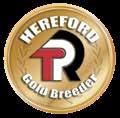
All bulls are guaranteed to be able to breed for the first breeding season, due to genetic and/or structural defects. Breeding season is defined as the 60-day period following the first time the bull(s) are turned out. If a replacement bull is available, he will be made available, or if the buyer prefers, credit toward a bull will be given in the following year’s sale. Salvage value of injured bull will be applied against replacement. Customers are encouraged to purchase mortality insurance on your bulls.
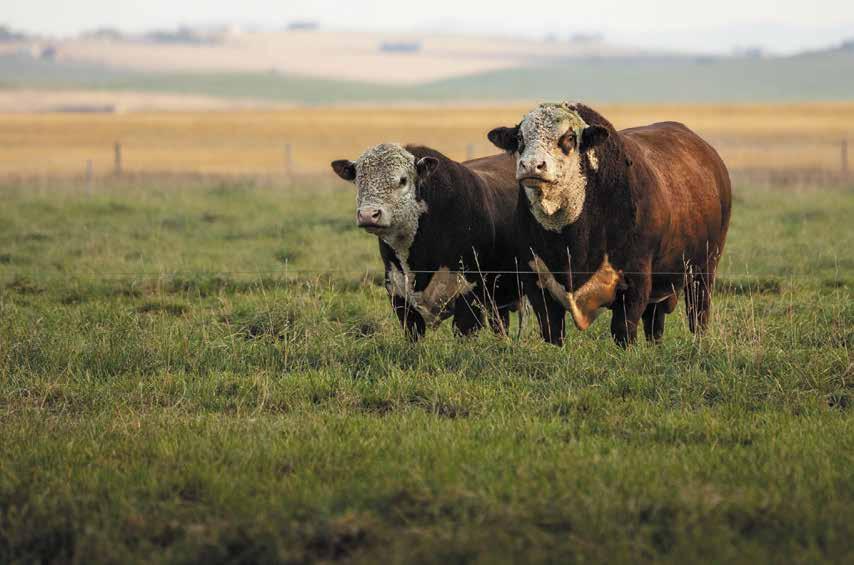

EHLKE HEREFORDS IN-HERD SEMEN USE
Ehlke Herefords reserves the right to in-herd semen use on the bulls in this offering, unless otherwise noted on individual animal footnotes.
DELIVERY ARRANGEMENTS
Free Delivery to central points within 500 miles. We will work with you on cost-effective delivery options outside of 500 miles. Delivery Discount –Haul your own, $150 credit applied to the purchase price. Bull(s) need to be picked up no later than April 15th in order to receive delivery discount credit.
HERD HEALTH
All bulls are in excellent health, have received modified live vaccines at branding, pre and post weaning; have received Multimin 90 and have been treated with Ivermectin Plus. All bulls will be semen tested and measured, and ultrasounded for carcass.
VOLUME BUYER DISCOUNT
REPEAT
BUYER DISCOUNT Enjoy 2% off your entire purchase if you have bought bulls from Ehlke
in the past. # of Bulls Purchased 2 3 4 5 6 7 8 9 10+ Discount applied to entire purchase 2% 3% 4% 5% 6% 7% 8% 9% 10% VIDEOS OF BULLS AVAILABLE WWW.EHLKEHEREFORDS.COM 3
Herefords
E Z712 SCHATZEE D83 [CHB]
{DLF, HYF, IEF, MSUDF, MDF}
POLLED | DOB: 3/14/16 | AHA#: 42818101
Heavily pigmented Schatzee son whose line bred dam adds to the predictability. D83 passes on his pigment, color and performance and will add ribeye area as well.
NJW 202C 81E STEWARD 98G
{DLF, HYF, IEF, MSUDF, MDF}
HOMOZYGOUS POLLED | DOB: 2/11/19 | AHA#: 44056521
We are thrilled to have been able to add 98G to our program. This guy brings an incredible maternal background into breeding decisions. 98G adds depth and dimension to his progeny. He is homozygous polled and the number profile backing this guy up is also exceptional. Owned with NJW Herefords, Harvie Ranching and RSK Farms. A 98G daughter was recently Reserve Grand Champion Polled Hereford Female at Agribition.
E T719 BRAXTON C009
{DLF,HYF,IEF,MSUDF,MDF}
HOMOZYGOUS POLLED | DOB: 1/22/15 | AHA#: 43587975
C009 is used to continue the Braxton influence. Braxton sired females are highly efficient and are very maternal and are an outcross pedigree. Owned with Anchor Polled Herefords.
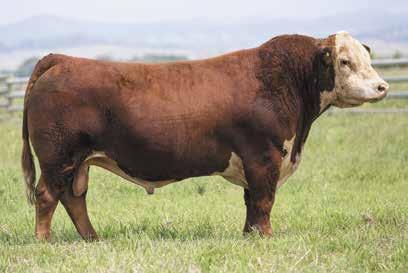


 GE•EPD AHA
GE•EPD AHA
REFERENCE SIRES
GE EPD AHA
4
GE EPD AHA
NJW 79Z 33B FORWARD 252F
{DLF, HYF, IEF, MSUDF, MDF}
HOMOZYGOUS POLLED | DOB: 3/11/18 | AHA#: 43943438
AI Sire used for his highly predictable performance. 252F progeny have been well received here.
ILR HOMETOWN 332A ET
{CHB, DLF, HYF, IEF, MSUDF, MDF}
POLLED | DOB: 10/2/13 | AHA#: 43385499
We continue to use 332A AI where we can. His influence runs deep in our program due to the predictability of his offspring. Owned with Woolfolk Herefords, McGuffee Polled Herefords and Iron Lake Ranch.

HerefordHeterosis
Hereford sired calves of Angus cows compared to Angus sired calves
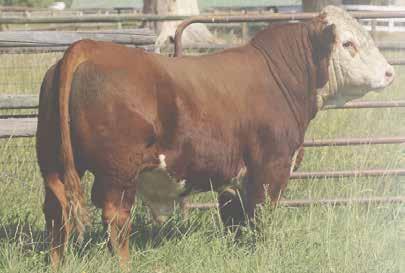

$51/head per year net cow profit
Feedlot - $30 to $78/head additional profitability
Replacements – 7% increase in fertility, vigor, fertility, longevity, more calves and increased replacement options
Feed efficiency, gain, lower morbidity and mortality Herefords are known for their quiet disposition; easier on equipment and people!

GE•EPD AHA
5

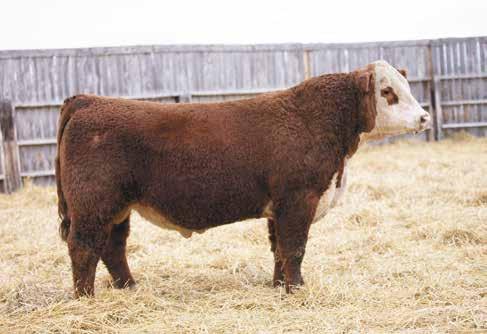
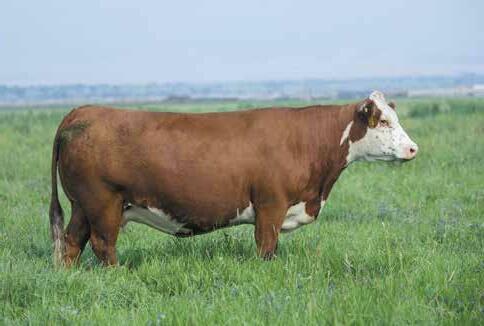
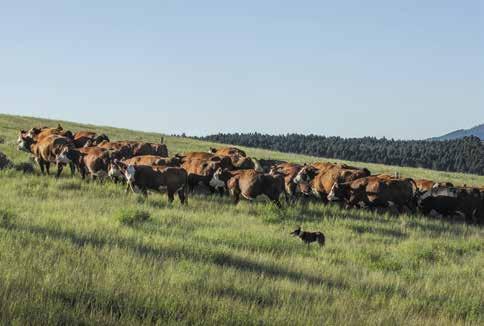

ERNST MS BUILT TUFF 499 Dam of J50 DAM J44 E Z712 SCHATZEE J44 {DLF,HYF,IEF,MSUDF} POLLED | BD: 8/5/21 | AHA#: 44309989 | Act. BW: 84 lbs. E 4L SCHATZEE ET Z712 CHURCHILL LADY 5164C HARVIE LADIES MAN 4L CHURCHILL RED BULL 200Z HARVIE MS FIREFLY ET 186W E MC 719 VICTORIA X1 MCW UDDR TEAT CW FAT REA Marb $BMI $BII $CHB 112 1.2 1.2 86 0.040 0.78 -0.23 $402 $465 $100 CE BW WW YW DMI SC SCF Milk M&G CEM 1.0 4.0 68 111 0.7 0.8 19.8 29 62 2.1 This is one of the highest performing individuals in the group of older bulls, J44 will add lbs. to a calf crop. J44’s dam is a Redbull daughter that ultimately
back
Catalina 24H. Firefly 51F and 002X add
maternal
J50 E 252F WYATT J50 {DLF,HYF,IEF,MSUDF} POLLED | BD: 8/10/21 | AHA#: 44310073 | Act. BW: 91 lbs. NJW 79Z 33B FORWARD 252F ERNST MS BUILT TUFF 499 NJW 160Z 10W WHIT 33B KT BUILT TUFF 1010 BW 91H 100W RITA 79Z ET ERNST MS 8619 DOMINO 248 MCW UDDR TEAT CW FAT REA Marb $BMI $BII $CHB 83 1.5 1.4 76 -0.021 0.51 0.17 $368 $447 $133 CE BW WW YW DMI SC SCF Milk M&G CEM 5.8 2.6 66 93 0.3 0.9 16.1 36 69 0.4 Deep set, heavily muscled, moderate framed 252F son out of a low BW cow from Ernst Herefords. J50 is well pigmented and posts a nice EPD profile as well. J56 E 4140B MILES J56 SCURRED | BD: 8/12/21 | AHA#: 44310035 | Act. BW: 85 lbs. ILR H MILES 4140B ET E 337U DIVA B056 C MILES MCKEE 2103 ET HARVIE SAFNBFI COLATERAL 337U BOYD E70 QUEEN 0118 E 7W LADY TAILOR Y625 MCW UDDR TEAT CW FAT REA Marb $BMI $BII $CHB 85 1.3 1.2 62 -0.002 0.38 0.11 $360 $435 $110 CE BW WW YW DMI SC SCF Milk M&G CEM 1.2 3.8 58 91 0.3 1.0 17.5 28 57 2.1 Short marked, well pigmented Miles 4140 son out of a productive 337U dam. Nice balance here. J56 is scurred. 6 18 MONTH OLD BULLS
goes
to
to the
aspect as well.




J58 E C009
POLLED | BD: 8/13/21 | AHA#: 44310083 | Act. BW: 82 lbs. E T719 BRAXTON C009 E B011 DOMINETTE D63 E BRAXTON 719 {SOD} E 306U SCOTCHMAN B011 E 337U DIVA A008 B LADY RAMBO 411 MCW UDDR TEAT CW FAT REA Marb $BMI $BII $CHB 93
68 0.030 0.41
$323 $123 CE BW WW YW DMI SC SCF Milk M&G CEM 5.0 2.3 47 73 0.0 0.4 9.7
41
C009 sired bull that goes back to Bayers breeding on the bottom side. Positive carcass indications here are a bonus as well as heavy pigment. 7J LJE 332A
7J HORNED | BD:
| AHA#: 44310077 | Act.
lbs. ILR HOMETOWN 332A ET {CHB} LJE 54Z LADY GUNNER 4F NJW 73S W18 HOMETOWN 10Y ET HARVIE GUNNER 54Z NJW 43T 4037 FOREVERN EDNA 28XET LJE Z712 GRACE 11D MCW UDDR TEAT CW FAT REA Marb $BMI $BII $CHB 102 1.4 1.3 68 0.030 0.47 0.11 $345 $414 $115 CE BW WW YW DMI SC SCF Milk M&G CEM 0.9 3.1 55 95 0.4 0.8 15.9 28 56 -2.4 Moderate framed 332A son. 7J posts a nicely balanced EPD profile and phenotypically backs it up. 7J ratioed at the top of his contemporary group for carcass characteristics. Dam is one of the better young cows on the ranch. J60 E 332A HOMETOWN J60 POLLED | BD: 8/15/21 | AHA#: 44309992 | Act. BW: 88 lbs. ILR HOMETOWN 332A ET {CHB} E 1414 DEBUTANTE E66 NJW 73S W18 HOMETOWN 10Y ET SR CCC TOP TIER 1414B ET NJW 43T 4037 FOREVERN EDNA 28XET E T719 PRECIOUS Z35 MCW UDDR TEAT CW FAT REA Marb $BMI $BII $CHB 76 1.3 1.3 69 0.020 0.47 0.11 $355 $417 $124 CE BW WW YW DMI SC SCF Milk M&G CEM 0.2 2.7 46 78 -0.1 0.7 16.2 30 53 0.9 332A son whose dam is a daughter of Z35, a donor we own with Hagen Cattle and Hay. Moderate framed bull here who should sire very useful cattle. E 1414 DEBUTANTE E66 Dam of J60 E 337U DIVA A008 Paternal Granddam of J58, J112 and Dam of K6 7
VAUGHN J58
1.2 1.1
0.20 $258
18
0.1
HOMETOWN
8/15/21
BW: 84
wellmarked, well made, typical Forward son. Moderate framed but real deep ribbed and heavily muscled. J62 has potential to add
weight and ribeye area. Nice bull here.


posted one of our higher yearling weights. There are some breed icons, especially on the top side of this pedigree. J69 will add lbs. to a calf crop without sacrificing the maternal aspect. J69 ratioed at the upper end of his contemporary group for IMF.
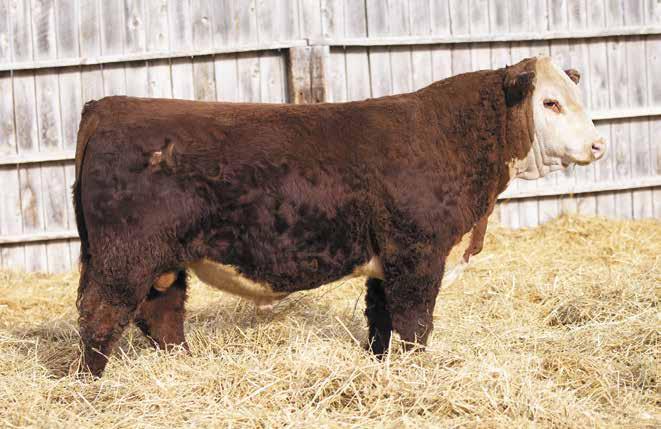
Goggle
J69 E 4140B MILES J69 SCURRED | BD: 8/18/21 | AHA#: 44310022 | Act. BW: 97 lbs. ILR H MILES 4140B ET E Z712 GRACE F48 C MILES MCKEE 2103 ET E 4L SCHATZEE ET Z712 BOYD E70 QUEEN 0118 E S638 ANCHOR LADY U803 MCW UDDR TEAT CW FAT REA Marb $BMI $BII $CHB 99 1.3 1.3 62 -0.010 0.52 0.14 $328 $401 $119 CE BW WW YW DMI SC SCF Milk M&G CEM -2.1 5.9 58 108 0.5 0.8 14.9 25 54 1.6 J62 E 252F WYATT J62 {DLF,HYF,IEF,MSUDF} POLLED | BD: 8/16/21 | AHA#: 44310086 | Act. BW: 81 lbs. NJW 79Z 33B FORWARD 252F E 4140B MS RILEY F8 NJW 160Z 10W WHIT 33B ILR H MILES 4140B ET BW 91H 100W RITA 79Z ET E Z712 GRACE D22 MCW UDDR TEAT CW FAT REA Marb $BMI $BII $CHB 92 1.4 1.2 80 0.010 0.64 0.09 $392 $462 $126 CE BW WW YW DMI SC SCF Milk M&G CEM 5.3 2.6 58 89 0.5 1.1 18.4 35 64 3.8 8 18 MONTH OLD BULLS Private Treaty Spring Bull Sale – Buyer’s Convenience – Select bulls when it’s convenient for you!
J69 J69
J62
eyed, dark red,
carcass
210
Son of past Agribition Champion Polled Hereford bull, Digby 20C. Calving ease is bred in here on bottom side. Digby daughters are making stand out cows here. Genomically Enhanced EPDs in process at AHA as of catalog printing.
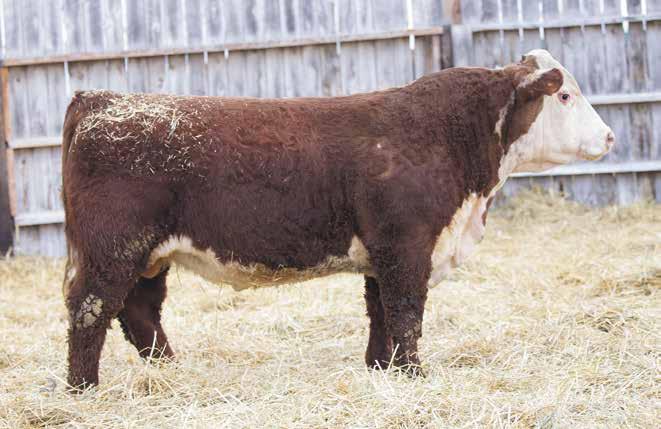
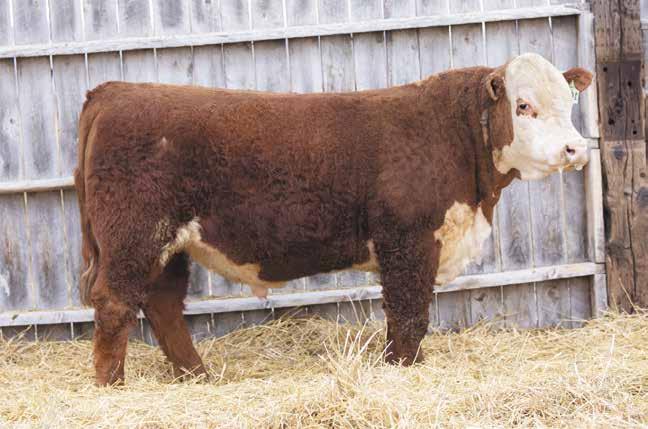
1010
Digby 20C out of one of the better Braxton 719 daughters we have raised. The maternal aspects are really solid here. 1010 should sire front pasture type females. Genomically Enhanced EPDs in process at AHA as of catalog printing.

LJE
ET
LJE
MCW UDDR TEAT CW FAT REA Marb $BMI $BII
-0.020 0.42 -0.03
CE BW WW YW DMI SC SCF Milk M&G
4.2
0.0 0.5
MCW UDDR TEAT CW FAT REA Marb $BMI
82
CE BW WW YW DMI SC SCF Milk
CEM
9 Online catalog and videos available on all sale bulls at www.ehlkeherefords.com
210 LJE 20C DIGBY 210 POLLED | BD: 8/18/21 | AHA#: 44310011 | Act. BW: 76 lbs. RSK E 2046 DIGBY ET 20C
203Z DANELLE 84 OTAPAWA SKYMATE 2046
HARVIE DAN SNIPER 203Z HARVIE MISS FIREFLY 51F
A012 LADY BRAXTON 68
$CHB 89 1.4 1.4 66
$345 $395 $106
CEM
1.9 48 75
16.0 24 48 -1.3 1010 E 20C DIGBY 1010 ET SCURRED | BD: 8/18/21 | AHA#: 44310103 | Act. BW: 80 lbs. RSK E 2046 DIGBY ET 20C E T719 LADY BRAXTON Z855 OTAPAWA SKYMATE 2046 ET E E BRAXTON 719 {SOD} HARVIE MISS FIREFLY 51F E M211 LADY RANGER U855
$BII $CHB
1.4 1.3 56 -0.001 0.22 0.03 $336 $390 $97
M&G
4.3 2.4 45 71 -0.1 0.8 16.2 25 48 0.5
11J
Goggle eyed, short marked, red to the ground 252F son that will add some performance to his progeny. The 252F sired cattle have been highly regarded here and 11J sure fits into the top end.
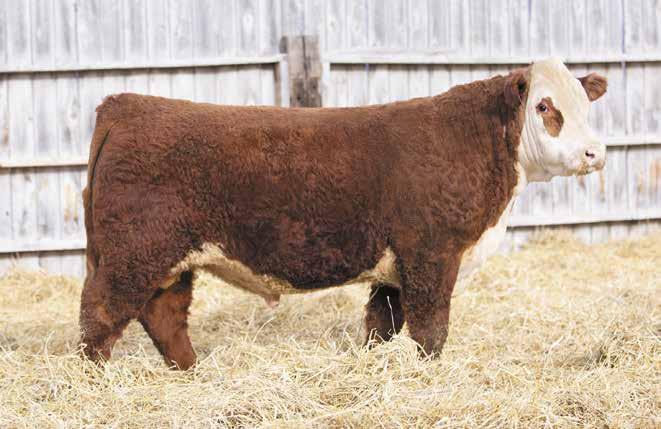
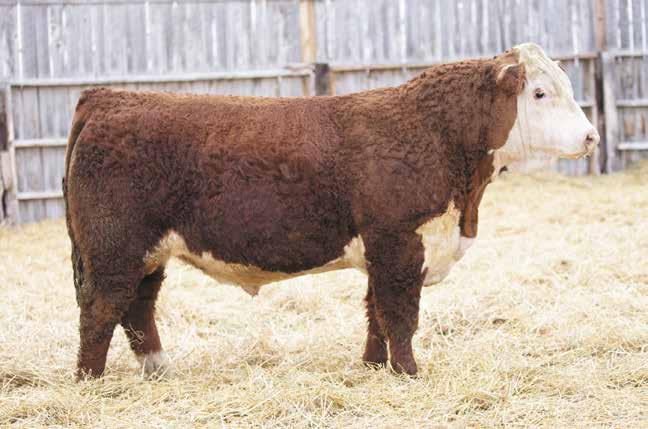
is a product of the Anchor program, making this guy bred a bit different. 12J will definitely add lbs and performance to a calf crop.

12J Another Forward son
LJE 252F
12J POLLED | BD: 8/20/21 | AHA#: 44309998 | Act. BW: 98 lbs. NJW 79Z 33B FORWARD 252F LJE 11X MISS ANCHOR 006A NJW 160Z 10W WHIT 33B ANCHOR 11X BW 91H 100W RITA 79Z ET ANCHOR 41Y MCW UDDR TEAT CW FAT REA Marb $BMI $BII $CHB 87 1.2 1.2 76 0.030 0.51 -0.01 $306 $383 $100 CE BW WW YW DMI SC SCF Milk M&G CEM -0.7 5.4 71 106 0.7 0.6 13.8 30 66 -2.0 11J LJE 252F
11J POLLED | BD: 8/20/21 | AHA#: 44310064 | Act. BW: 84 lbs. NJW 79Z 33B FORWARD 252F LJE 337U DIVA 021B NJW 160Z 10W WHIT 33B HARVIE SAFNBFI COLATERAL 337U BW 91H 100W RITA 79Z ET ANCHOR 22Y MCW UDDR TEAT CW FAT REA Marb $BMI $BII $CHB 94 1.4 1.2 68 -0.020 0.43 -0.06 $338 $402 $95 CE BW WW YW DMI SC SCF Milk M&G CEM 4.7 3.7 63 96 0.5 0.6 16.3 26 58 2.3 10 18 MONTH OLD BULLS EPDs are highlighted to show percentile rank within the breed • Green Top 10% • Orange Top 25%
whose dam
12J
WYATT
WYATT

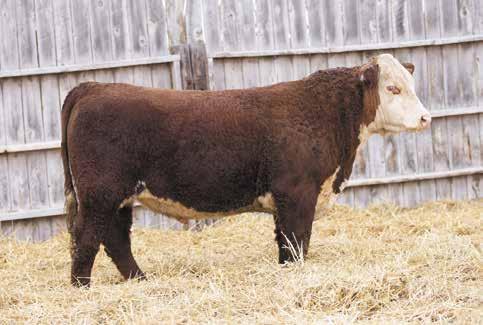
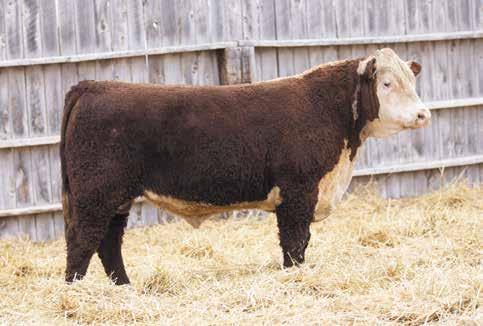
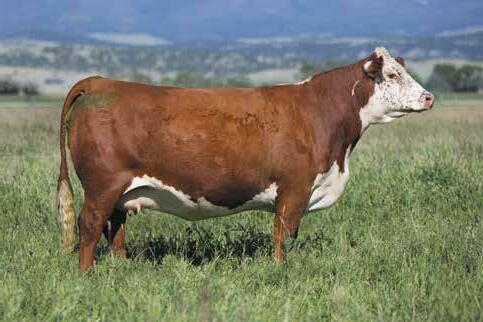
J75 E D98 SPECTRE J75 SCURRED | BD: 8/21/21 | AHA#: 44310076 | Act. BW: 88 lbs. E ILR ATHENS D98 E 337U DIVA A030 ILR HOMETOWN 332A ET HARVIE SAFNBFI COLATERAL 337U HARVIE E MS FIREFLY ET 19Z BE MISS ANCHOR 342 MCW UDDR TEAT CW FAT REA Marb $BMI $BII $CHB 94 1.4 1.3 84 -0.002 0.84 -0.04 $407 $471 $114 CE BW WW YW DMI SC SCF Milk M&G CEM -0.8 3.7 64 105 0.8 0.6 19.6 32 64 0.5 Dark red bull here with good pigment and a touch more frame. J75 will add lbs and ribeye to his progeny. J75’s sire will see continued use here. J76 E 332A HOMETOWN J76 POLLED | BD: 8/23/21 | AHA#: 44310080 | Act. BW: 83 lbs. ILR HOMETOWN 332A ET {CHB} E 54Z LADY GUNNER F55 NJW 73S W18 HOMETOWN 10Y ET HARVIE GUNNER 54Z NJW 43T 4037 FOREVERN EDNA 28XET CHURCHILL LADY 1172Y ET MCW UDDR TEAT CW FAT REA Marb $BMI $BII $CHB 99 1.3 1.3 71 -0.010 0.50 0.01 $336 $395 $116 CE BW WW YW DMI SC SCF Milk M&G CEM 0.1 3.3 55 92 0.2 0.9 14.9 27 55 -1.9 Nicely balanced 332A son here. 332A just continues to work for us. J76 should sire functional cattle that will feed out well. 1015 E 252F WYATT 1015 ET POLLED | BD: 8/23/21 | AHA#: 44310008 | Act. BW: 91 lbs. NJW 79Z 33B FORWARD 252F E 332A EDNA D160 NJW 160Z 10W WHIT 33B ILR HOMETOWN 332A ET BW 91H 100W RITA 79Z ET ILR 156T IRON LADY 486B ET MCW UDDR TEAT CW FAT REA Marb $BMI $BII $CHB 99 1.2 1.2 79 -0.031 0.68 -0.05 $347 $412 $116 CE BW WW YW DMI SC SCF Milk M&G CEM -0.8 4.5 64 106 0.5 1.1 15.5 33 65 1.7 Dam is our D160 donor cow and sired by 252F which adds a high level of predictability to the performance and maternal aspect of 1015. This bull deserves a second look. E 332A EDNA D160 Dam of 1015 and J98 11
1017
One of two full brothers on offer. One cannot help but admire how they are put together. 1017’s dam, 184W has been a favorite of visitors her entire career and she is still working here. Solid prospect whose carcass ratios are at the top end. 1023 Full brother to 1017. Just a really good bull here whose IMF ratio is at the top of the class. 1023 may be the “sleeper” in the pen this year.

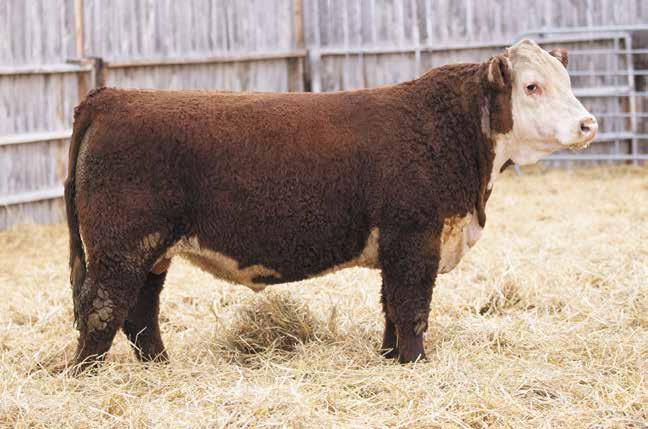

{DLF,HYF,IEF,MSUDF} HOMOZYGOUS POLLED | BD:
| AHA#:
| Act. BW:
BR
HARVIE
ET
NJW 73S 980 HUTTON
ET HARVIE
BR CSF
8052 ET MHPH MS
MCW UDDR TEAT CW FAT REA Marb $BMI $BII $CHB 121 1.3 1.2 67 -0.020 0.55 0.06 $363 $427 $116 CE BW WW YW DMI SC SCF Milk M&G CEM 1.0 5.0 56 94 0.4 0.7 16.7 20 48 1.1
BR
MCW UDDR TEAT CW FAT REA Marb $BMI $BII $CHB 105 1.3 1.3 66 0.010 0.47 0.18 $379 $452 $123 CE BW WW YW DMI SC SCF Milk M&G CEM 1.2 4.9 59 99 0.4 0.6 17.7 24 53 1.3 12 18 MONTH OLD BULLS Pick your bulls now – take possession in April
1017 E 4030 AUGUSTUS 1017 ET
8/24/21
44315486
104 lbs.
HUTTON 4030
MISS MEDONTE
184W
109Z
RAFTSMAN 16R
BRIELLE
24K PRINCESS 1195N
1023 E 4030 AUGUSTUS 1023 ET {DLF,HYF,IEF,MSUDF} POLLED | BD: 8/28/21 | AHA#: 44315484 | Act. BW: 102 lbs. BR HUTTON 4030 HARVIE MISS MEDONTE ET 184W NJW 73S 980 HUTTON 109Z ET HARVIE RAFTSMAN 16R
CSF BRIELLE 8052 ET MHPH MS 24K PRINCESS 1195N
red, short marked and heavily pigmented. J79 posts a very respectable number profile as well. Maternal aspect behind J79 is for real as well. Nice bull here.
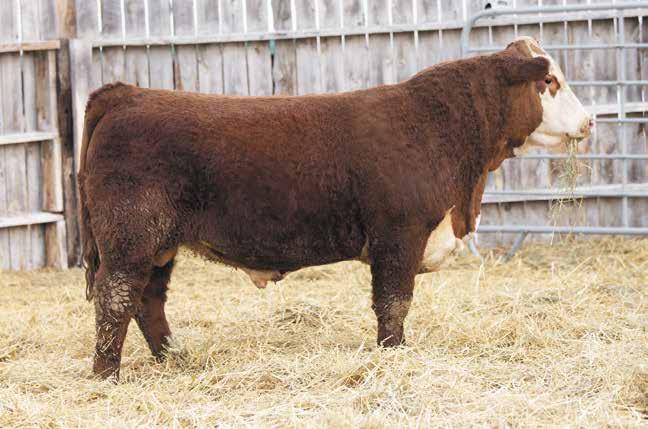

eyed, short marked, dark red C009 son out of one of our better 332A daughters. J80 is sound footed and moves freely.

Goggle
J79 Forward
J79 E 252F WYATT J79 POLLED | BD: 8/24/21 | AHA#: 44310082 | Act. BW: 77 lbs. NJW 79Z 33B FORWARD 252F E 337U DIVA 09B ET NJW 160Z 10W WHIT 33B HARVIE SAFNBFI COLATERAL 337U BW 91H 100W RITA 79Z ET GV 579 VICTORIA 9710 MCW UDDR TEAT CW FAT REA Marb $BMI $BII $CHB 90 1.3 1.3 71 -0.020 0.53 -0.08 $351 $413 $97 CE BW WW YW DMI SC SCF Milk M&G CEM 7.2 2.1 62 86 0.4 0.6 16.9 29 60 2.8 J80 E C009 VAUGHN J80 {DLF,HYF,IEF,MSUDF} HOMOZYGOUS POLLED | BD: 8/25/21 | AHA#: 44310097 | Act. BW: 84 lbs. E T719 BRAXTON C009 E 332A EDNA E85 E BRAXTON 719 {SOD} ILR HOMETOWN 332A ET E 337U DIVA A008 WCC 293W 413X BRANDY 10B MCW UDDR TEAT CW FAT REA Marb $BMI $BII $CHB 68 1.3 1.3 71 0.060 0.50 0.06 $298 $359 $112 CE BW WW YW DMI SC SCF Milk M&G CEM 7.2 3.7 53 97 0.5 0.6 13.4 22 49 3.6 ILR 156T IRON LADY 486B ET Dam of 1025 and J103 13 BALANCE, always – no single trait selection
J80
son that is dark
1025

This is the result of Braxton 719 on our 486B donor cow. Braxton 719 semen is very limited, this could very well be the last son offered. The maternal aspect here will be tough to duplicate. 1025 is starting to show a freckled face. Genomically Enhanced EPDs in process at AHA as of catalog printing.
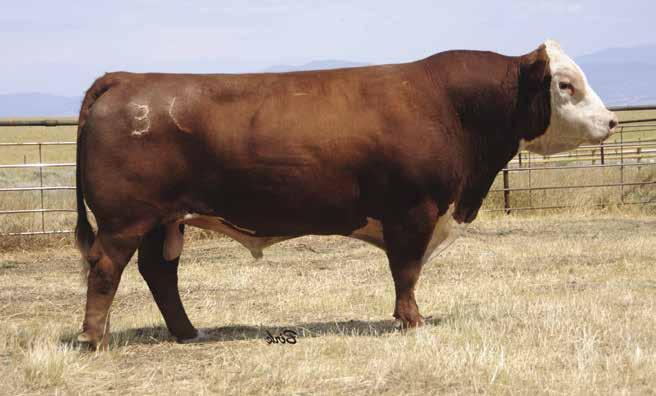
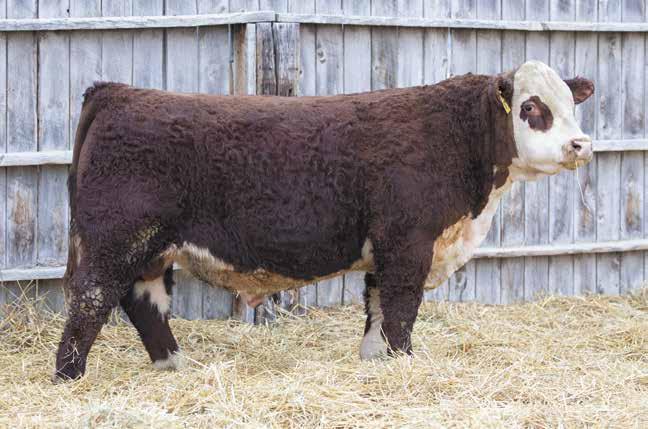
A
1025 E
SCURRED | BD: 8/29/21 | AHA#: 44310052 | Act. BW:
lbs. E BRAXTON 719 {SOD} ILR 156T IRON LADY 486B ET ANCHOR BRAXTON CMR GVP MR MATERNAL 156T ANCHOR 17R DJB 46B BETH 1L MCW UDDR TEAT CW FAT REA Marb $BMI $BII $CHB 63 1.2 1.3 71 0.030 0.64 0.15 $384 $450 $125 CE BW WW YW DMI SC SCF Milk M&G CEM 2.4 2.2 46 68 -0.2 0.8 17.7 32 55 3.0 J87 E
{DLF,HYF,IEF,MSUDF} POLLED | BD: 8/30/21 | AHA#: 44310090 | Act. BW: 84 lbs. BOYD 31Z BLUEPRINT 6153 E MC 7W LADY TAILOR Z737 {DOD} R LEADER 6964 HARVIE TAILOR MADE ET 7W NJW 91H 100W RITA 31Z ET MC E CC OPTIMA 23H T737 ET MCW UDDR TEAT CW FAT REA Marb $BMI $BII $CHB 67 1.5 1.5 59 0.040 0.26 -0.07 $321 $389 $79 CE BW WW YW DMI SC SCF Milk M&G CEM 7.2 1.3 50 81 0.2 0.8 16.6 30 55 4.5 E BRAXTON 719 Sire of 1025 14 18 MONTH OLD BULLS Hereford Heterosis – proven advantages in feedlot profitability,
J87
Blueprint 6153, whose dam is a DOD, that is extremely deep set. J87 is dark red and is goggle eyed, as well as being moderate framed. J87 catches all visitors’ attention. Nice bull here.
T719 BRAXTON 1025 ET
86
6153 ROYAL J87


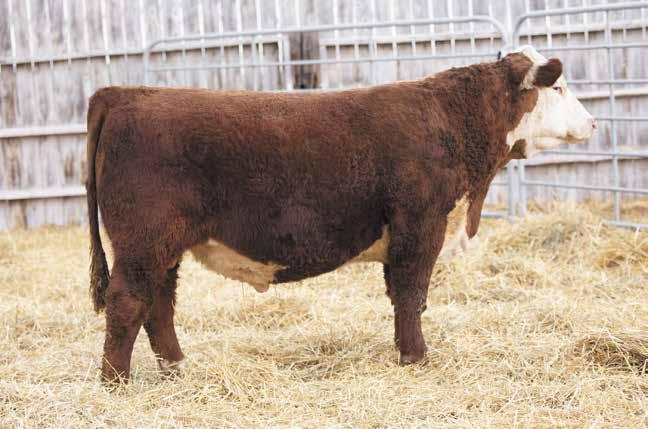
One of two full brothers here
1019 LJE 332A HOMETOWN 1019 ET POLLED | BD: 8/25/21 | AHA#: 44310107 | Act. BW: 86 lbs. ILR HOMETOWN 332A ET {CHB} STAR BE STILL MY HEART 273U NJW 73S W18 HOMETOWN 10Y ET REMITALL ONLINE 122L NJW 43T 4037 FOREVERN EDNA 28XET RB L1 DOMINETTE 8116 MCW UDDR TEAT CW FAT REA Marb $BMI $BII $CHB 81 1.3 1.2 60 -0.020 0.31 0.06 $255 $307 $113 CE BW WW YW DMI SC SCF Milk M&G CEM 0.4 2.5 46 78 -0.1 0.7 9.9 25 48 -0.7 1028 LJE 332A HOMETOWN 1028 ET POLLED | BD: 9/2/21 | AHA#: 44310108 | Act. BW: 92 lbs. ILR HOMETOWN 332A ET {CHB} STAR BE STILL MY HEART 273U NJW 73S W18 HOMETOWN 10Y ET STAR BRIGHT FUTURE 533P ET NJW 43T 4037 FOREVERN EDNA 28XET MSU APOLLONIA 10M MCW UDDR TEAT CW FAT REA Marb $BMI $BII $CHB 81 1.3 1.2 60 -0.001 0.30 0.10 $257 $312 $114 CE BW WW YW DMI SC SCF Milk M&G CEM 0.6 2.5 46 78 -0.2 0.7 9.9 25 48 -0.7 15 fertility increase, cow herd size and net cow profit.
1028 Full brother to 1019 bull. 1028 is a bit longer and has a touch more frame than 1019. 1028 is short marked and red to the ground. 1019
as well. 332A x 273U, a cow who stems from Michigan State University and Star Lake Ranch, making 1019 uniquely bred for sure.

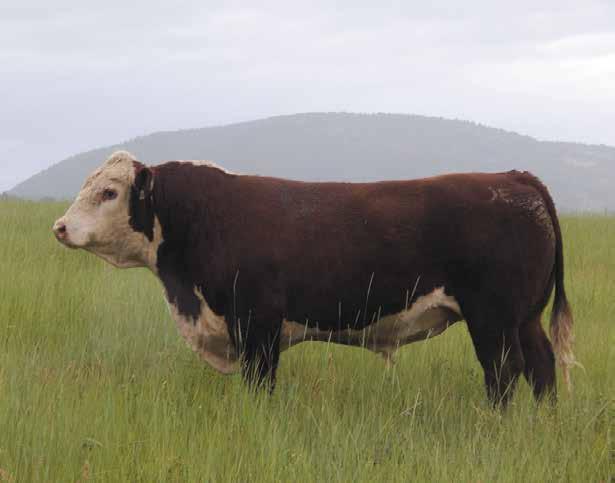

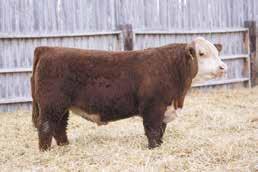
J96 Definite
J98 Dark red, short marked 203Z son
framed, negative
us
J96 E D83 SHINER J96 {DLF,HYF,IEF,MSUDF} POLLED | BD: 9/6/21 | AHA#: 44309988 | Act. BW: 87 lbs. E Z712 SCHATZEE D83 E T719 LADY BRAXTON A023 E 4L SCHATZEE ET Z712 E BRAXTON 719 {SOD} EPHN LINNETTE 530T E S604 MCW UDDR TEAT CW FAT REA Marb $BMI $BII $CHB 100 1.2 1.1 100 0.040 0.89 -0.01 $421 $504 $139 CE BW WW YW DMI SC SCF Milk M&G CEM -8.2 5.6 70 106 0.4 0.3 19.3 24 59 -2.6 J98 E 203Z SNIPER J98 {DLF,HYF,IEF,MSUDF} POLLED | BD: 9/7/21 | AHA#: 44310009 | Act. BW: 95 lbs. HARVIE DAN SNIPER E 332A EDNA D160 TH 122 71I VICTOR 719T ILR HOMETOWN 332A ET HARVIE DAN MS FIREFLY 69S ILR 156T IRON LADY 486B ET MCW UDDR TEAT CW FAT REA Marb $BMI $BII $CHB 73 1.3 1.4 78 -0.010 0.59 0.09 $382 $448 $136 CE BW WW YW DMI SC SCF Milk M&G CEM 5.1 2.4 54 83 -0.1 0.9 16.7 33 61 2.4 HARVIE DAN SNIPER Sire of J98 and J103 16 18 MONTH OLD BULLS EPDs are highlighted to show percentile rank within the breed • Green Top 10% • Orange Top 25%
Herd Bull prospect here. J96 is very well made, has a deep, well-muscled look and moves freely. J96 will add lbs. at weaning and yearling stages to a calf crop. Hard to find any holes in this one.
out of a 332A daughter that goes back to the Beth IL cow. The 203Z bull was a moderate
BW bull that left
some exceptional cows. Very useful genetic package here.

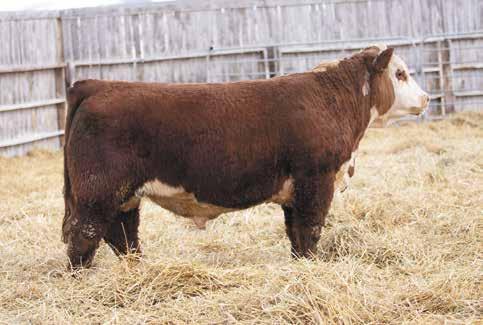


J102 E D83 SHINER J102 POLLED | BD: 9/8/21 | AHA#: 44310001 | Act. BW: 83 lbs. E Z712 SCHATZEE D83 E D98 BIG SKY MISS F69 E 4L SCHATZEE ET Z712 E ILR ATHENS D98 EPHN LINNETTE 530T E T719 LADY BRAXTON Z855 MCW UDDR TEAT CW FAT REA Marb $BMI $BII $CHB 96 1.2 1.1 76 0.040 0.61 0.05 $383 $450 $113 CE BW WW YW DMI SC SCF Milk M&G CEM 3.3 2.7 56 91 0.5 0.8 18.6
D83 son that is well balanced in the flesh and on paper. J102 is
and is
framed. J103 E 203Z SNIPER J103 POLLED | BD:
| AHA#: 44310054 | Act.
lbs. HARVIE DAN SNIPER ILR 156T IRON LADY 486B ET TH 122 71I VICTOR 719T CMR GVP MR MATERNAL 156T HARVIE DAN MS FIREFLY 69S DJB 46B BETH 1L MCW UDDR TEAT CW FAT REA Marb $BMI $BII $CHB 59 1.4 1.5 68 -0.020 0.58 0.05 $404 $463 $121 CE BW WW YW DMI SC SCF Milk M&G CEM 5.7 0.8 45 81 -0.1 1.2 19.6 34 56 3.4 Big Topped, moderate framed 203Z son out of our 486B donor cow, who has a deep rib set. J103 is bred very similar to J98, but has a heavier muscle pattern. The maternal background here is exceptional, and the calving ease adds to the appeal of this bull. Genomically Enhanced EPDs in process at AHA as of catalog printing. J112 LJE C009 VAUGHN J112 {DLF,HYF,IEF,MSUDF} POLLED | BD: 9/11/21 | AHA#: 44309996 | Act. BW: 80 lbs. E T719 BRAXTON C009 LJE 2504 MISS SENSATION 85 E BRAXTON 719 {SOD} UPS SENSATION 2504 ET E 337U DIVA A008 E M211 LADY RANGER 0813 MCW UDDR TEAT CW FAT REA Marb $BMI $BII $CHB 72 1.4 1.4 57 -0.001 0.43 0.16 $364 $432 $106 CE BW WW YW DMI SC SCF Milk M&G CEM 4.3 2.2 48 72 0.1 0.5 17.8 27 50 1.8 Moderate framed C009 son who is above breed average for C.E. and B.W. The Braxton influence is a maternal guarantee and is an outcross to most popular bloodlines of today’s breeding decisions. 17
23 51 2.9
short marked and well pigmented
moderate
9/9/21
BW: 78
example of a mating that sure works for us, the performance of D83 and the predictability of 332A.
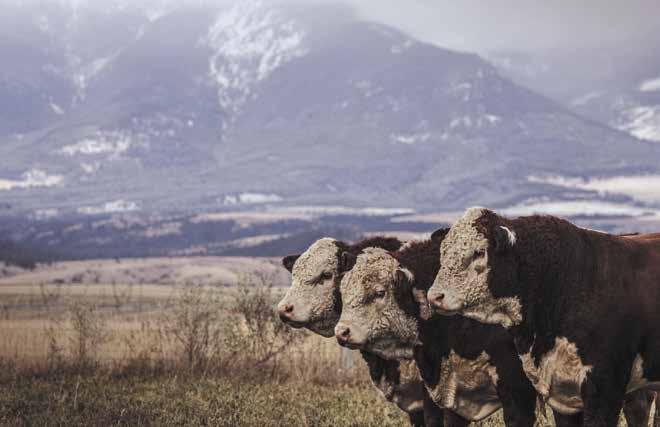
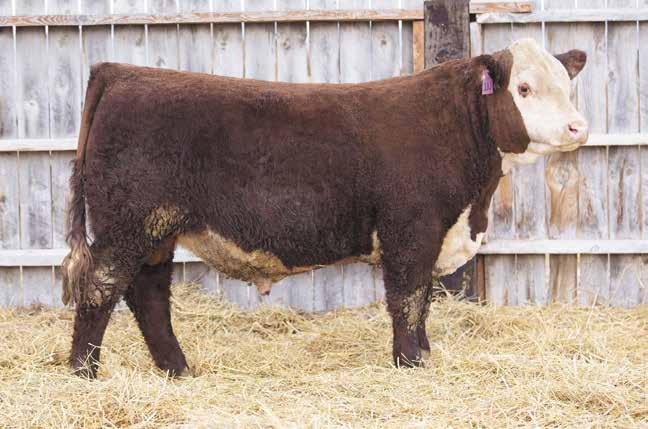

18J Dark, red
18J is
J116 Moderate framed Braxton X 332A bred bull here that is also line bred Colateral 337U. Who is a trait leader for udder quality. Nice maternal package here. J116 E F78 BRAXTON J116 POLLED | BD: 9/14/21 | AHA#: 44310100 | Act. BW: 96 lbs. E A012 BRAXTON F78 E 332A EDNA E153 E719 BRAXTON A012 ILR HOMETOWN 332A ET E 337U DIVA B061 E 337U DIVA A058 MCW UDDR TEAT CW FAT REA Marb $BMI $BII $CHB 72 1.3 1.4 55 -0.001 0.34 0.05 $333 $395 $91 CE BW WW YW DMI SC SCF Milk M&G CEM -6.4 4.9 53 84 0.2 0.8 16.4 26 53 -4.9 18J LJE D83 SHINER 18J {DLF,HYF,IEF,MSUDF} POLLED | BD: 9/20/21 | AHA#: 44310074 | Act. BW: 87 lbs. E Z712 SCHATZEE D83 LJE 332A EDNA 12F E 4L SCHATZEE ET Z712 ILR HOMETOWN 332A ET EPHN LINNETTE 530T LJE Z833 MARVEL 007C MCW UDDR TEAT CW FAT REA Marb $BMI $BII $CHB 108 1.1 0.9 78 0.040 0.55 -0.03 $297 $351 $105 CE BW WW YW DMI SC SCF Milk M&G CEM -2.4 4.2 57 100 0.7 1.0 12.9 19 47 0.5 18 18 MONTH OLD BULLS THANK YOU to our customers – we appreciate you!
to the ground, well pigmented, all of which are trademarks of 18J’s sire D83.
an
son who ratioed high among his contemporaries for IMF. Bottom side of J127’s pedigree is an outcross to most and bull boasts nice pigment. 98G progeny are gaining attention both in the US and in Canada as well.
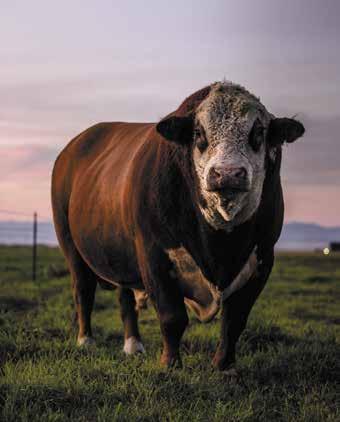
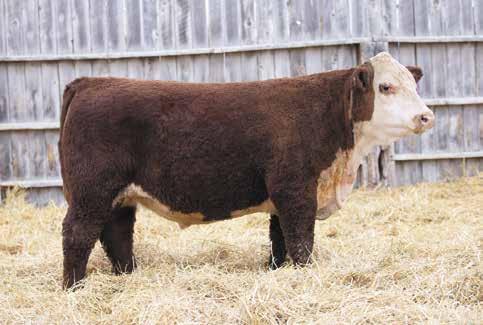
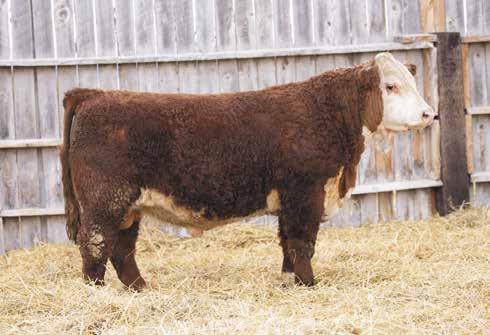

218
LJE D83 SHINER 218
1.4 1.4 75 0.018 0.48 0.02 $424 $500 $105 CE BW WW YW DMI SC SCF Milk M&G CEM 2.2 4.0 62 98 0.7 0.3 21.9 19 50 1.9 J29 was held back out of last years offering for a possible replacement bull that we ended up not turning out. Udder quality is bred in here, daughters will
the replacement
top end of the breed in the
loads of
J127 E 98G WOODROW J127 POLLED | BD: 9/26/21 | AHA#: 44310018 | Act. BW: 94 lbs. NJW 202C 81E STEWARD 98G ET {CHB} E 61Z BERVA C061 NJW 160B028X HISTORIC 81E ET
61Z NJW
HOME MAKER 202C B LADY
223 MCW UDDR TEAT CW FAT REA Marb $BMI $BII $CHB 79
62 0.020 0.41 0.20 $398 $476
CE BW WW YW DMI SC SCF Milk M&G CEM -0.7 3.3 56 89 0.3 1.1 19.6 38 66 -1.3
19
POLLED | BD: 9/30/21 | AHA#: 44310057 | Act. BW: 90 lbs. E Z712 SCHATZEE D83 LJE 203Z FAITH 610 E 4L SCHATZEE ET Z712 HARVIE DAN SNIPER 203Z EPHN LINNETTE 530T LJE 337U DIVA 008B MCW UDDR TEAT CW FAT REA Marb $BMI $BII $CHB 90 1.3 1.2 72 0.030 0.45 0.04 $397 $474 $105 CE BW WW YW DMI SC SCF Milk M&G CEM 1.8 3.4 63 93 0.5 0.9 20.1 23 54 0.4 Very stylish D83 son whose dam just keeps getting it done. It would be hard to mark one up any better than 218. Just a real nice bull here. J29 E D83 SHINER J29 POLLED | BD: 3/28/21 | AHA#: 44246555 | Act. BW: lbs. E Z712 SCHATZEE D83 E 337U DIVA A102 E 4L SCHATZEE ET Z712 HARVIE SAFNBFI COLATERAL 337U EPHR LINNETTE 530T MC GEN QUEEN 9904 MCW UDDR TEAT CW FAT REA Marb $BMI $BII $CHB 107
be
kind,
Maternal Indexes. J29 is dark red with
pigment.
ANCHOR
160Z8Y
NORTHSTAR
1.2 1.1
$115
98G
104 Real solid made 98G son. Deep rib set, big top with a heavily muscled hip. 104 is solidly marked with a nice eye set. 18 MONTH OLD BULLS Dams with high quality udders, desirable body capacity/muscle...
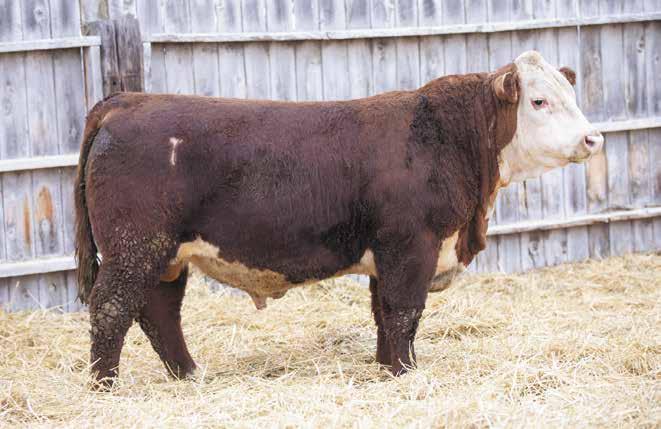


106 9013 17F CHESTER 106
8/19/21
POLLED | BD:
|
|
E
ET LJE
MS
KCF BENNETT ENCORE Z311 ET ILR H MILES
ET RSK 719T MISS SAGE 14B LJE
MCW UDDR TEAT CW FAT REA Marb $BMI $BII $CHB 104 1.2 1.2 64 -0.001 0.30 0.20 $382 $466 $127 CE BW WW YW DMI SC SCF Milk M&G
1.9 3.6 61 100 0.1 1.2 17.8
POLLED | BD:
|
NJW
81E STEWARD 98G ET {CHB} E
D73 NJW
HISTORIC 81E ET SR CCC TOP TIER 1414B ET NJW
HOME
202C E 337U DIVA
MCW UDDR TEAT CW FAT REA Marb $BMI $BII $CHB 90
70 -0.002 0.62 0.20 $382
$127 CE BW WW YW DMI SC SCF Milk M&G CEM 1.8
99 0.2 0.9
28
106 Long spined bull that goes back to some breed notables on both top and bottom side of his pedigree. Nice maternal background here. 20
AHA#: 44385595
Act. BW: lbs.
7311 ENCORE 9013
4140B
RILEY 17F
4140B
337U DIVA 003B
CEM
25 56 4.4 104 98G D73 LEWIS 104
8/14/21
AHA#: 44385595 | Act. BW: lbs.
202C
1414 DEBUTANTE
160B028X
160Z8Y
MAKER
A089
1.16 1.4
$466
4.1 54
20.6
55 4.2 This year we are pleased to be offering 4 bulls from Tudahl Herefords. These bulls were bred in our program and are progeny from a group of bred cows we sold to Tudahl Herefords. These bulls are in with the rest of the bulls for your viewing ease and consideration.
pigmented, dark red to the ground, D83 son whose dam has a shot of Miles McKee and Braxton 719 in her pedigree. Nice bull here.
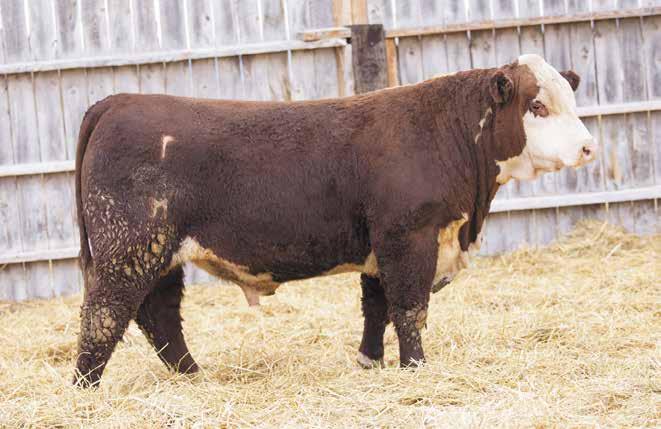

Another D83 son who is short marked, as red as you can make one and is goggle eyed. A real performance bull here that is well put together.

110
110 D83 E63
POLLED | BD: 8/27/21 | AHA#: 44385599 | Act. BW: lbs. E Z712 SCHATZEE D83 E 4140 MS RILEY E63 E 4L SCHATZEE ET Z712 ILR H MILES 4140B ET EPHN LINNETTE 530T E T719 LADY BRAXTON A039 MCW UDDR TEAT CW FAT REA Marb $BMI $BII $CHB 108 1.3 1.2 71 0.003 0.52 0.07 $375 $448 $113 CE BW WW YW DMI SC SCF Milk M&G CEM -1.1 3.9 60 92 0.3 0.8 17.8 24 54 1.8 114 D83
POLLED | BD: 9/10/21 | AHA#: 44385600 | Act. BW: lbs. E Z712 SCHATZEE D83 LJE Z833 MARVEL 007C E 4L SCHATZEE ET Z712 E MC 7W SOLID ET Z833 EPHN LINNETTE 530T LJE S638 SASSY Y702 MCW UDDR TEAT CW FAT REA Marb $BMI $BII $CHB 107 1.3 1.1 71 0.013 0.46 0.06 $335 $401 $111 CE BW WW YW DMI SC SCF Milk M&G CEM -0.3 3.6 55 90 0.3 0.9 15.4 15 42 3.4 21 ... structural integrity, youthfulness and maternal character
114
Heavily
WILLY 110
007C BOND 114
calving ease son of 98G with real nice carcass indications as well. K1 weaned off his 2-year-old dam at 730 lbs. A real solid maternal background here as well. K1 is moderate framed with a deep rib set and heavily muscled hip.

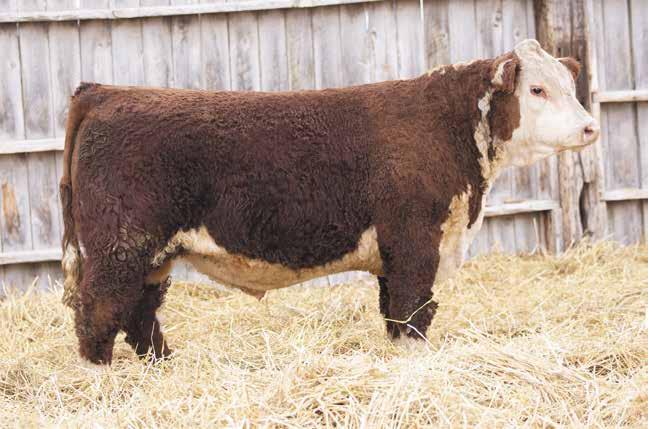

K1
YEARLING BULLS • Latest genetic offering • Physically smaller for heifer breeding • Potentially longer productive life • May work better in multiple sire pasture setting than older bulls 18 MONTH OLD AND 2 YEAR OLD BULLS • Ability to service larger group of cows • Potentially better suited for covering large rugged pastures • Mature characteristics more likely apparent Comparing Benefits of Bull Maturity K1 E 98G WOODROW K1 POLLED | BD: 1/24/22 | AHA#: 44357324 | Act. BW: 75 lbs. NJW 202C 81E STEWARD 98G ET {CHB} E 172E JANICE H001 NJW 160B028X HISTORIC 81E ET NJW 0118 8Y HOMEGROWN 172E ET NJW 160Z8Y HOME MAKER 202C E T719 LADY BRAXTON F27 MCW UDDR TEAT CW FAT REA Marb $BMI $BII $CHB 80 1.3 1.4 66 0.040 0.58 0.25 $458 $535 $124 CE BW WW YW DMI SC SCF Milk M&G CEM 10.0 0.3 49 73 0.1 0.9 23.0 37 61 4.1 22 YEARLING BULLS Bulls for sale come from top 25% of bull calf crop
Low BW,
Sooner son whose dam is a granddaughter of firefly 51F. and is of donor quality. K4 is very well put together and has a nice overall balance, with good pigment. Maternal, udder quality all bred in here. K4 is worth a second look.
2K
A real shining example of blending performance and maternal pedigrees. 2K is a product of some of the most used bloodlines in our program’s history. 2K is well balanced on paper and in the flesh. Very nicely pigmented bull as well. This guy weaned just shy of 800 lbs on milk and grass. A real solid prospect here.
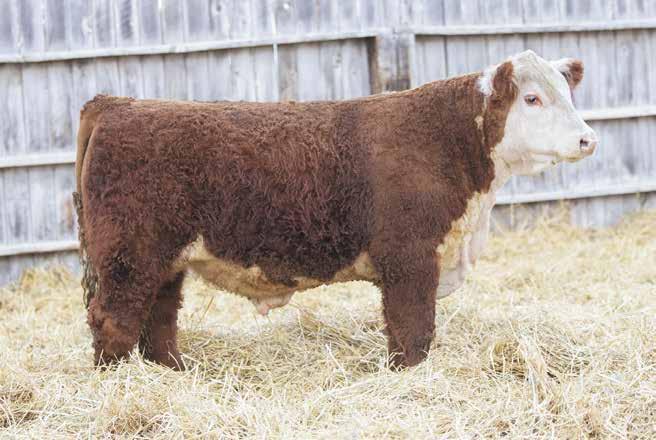


K4 E 6112 MS SOONER K4 POLLED | BD: 1/30/22 | AHA#: 44357320 | Act. BW: 87 lbs. ILR U201 SOONER 6112 ET {CHB} E 507C LADY DEW 9011 DM BR SOONER CHURCHILL TORO 507C ET KCF MISS PROFICIENT U201 E MC P316 MS NASDAQ 701A ET MCW UDDR TEAT CW FAT REA Marb $BMI $BII $CHB 73 1.5 1.5 66 -0.010 0.68 0.09 $407 $474 $123 CE BW WW YW DMI SC SCF Milk M&G CEM 5.3 2.3 54 88 0.1 0.9 19.4 29 56 1.6 2K LJE 0001 YELLOWSTONE 2K POLLED | BD: 2/18/22 | AHA#: 44357315 | Act. BW: 88 lbs. E 174E YELLOWSTONE 0001 ET LJE D31 JAN 18G TH FRONTIER 174E E Z712 SCHATZEE D31 E 332A EDNA D160 E Z545 DIVA MISCHIEF 032B MCW UDDR TEAT CW FAT REA Marb $BMI $BII $CHB 98 1.3 1.3 76 0.030 0.68 -0.05 $412 $488 $110 CE BW WW YW DMI SC SCF Milk M&G CEM 5.1 3.0 63 103 0.4 1.2 19.9 38 68 5.2 23 Take Advantage of Repeat Buyer and Volume Discounts
K4 A
First of the four G41 sons in our small yearling offering. These four bulls are all very similar in their makeup, moderate framed and very deep set. They are all short marked and solid red. K6 is out of one of the best uddered cows on the ranch, who is also the dam of our C009 bull who we used quite heavily. E CANTON G41 Sire of K6, K7, K8, K10

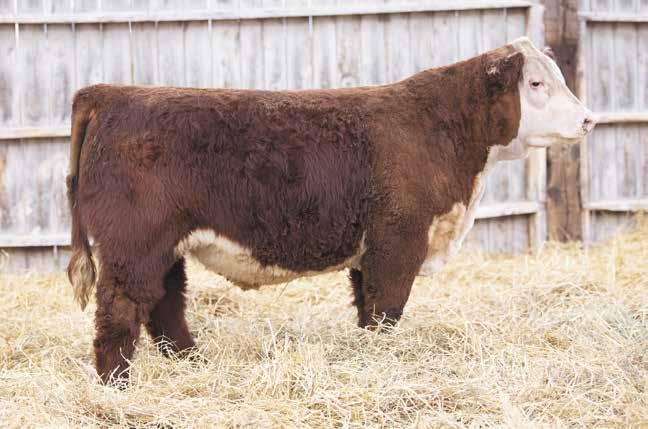

to
really
K7’s dam
of the Firefly line that is so
K7
E
MCW UDDR TEAT CW FAT REA Marb
0.010
CE BW WW YW DMI SC SCF Milk
E
CE
Younger aged bull that is
starting
develop.
is
maternal. K6 E G41 CANTON K6 POLLED | BD: 3/22/22 | AHA#: 44357317 | Act. BW: 98 lbs. E CANTON G41 E 337U DIVA A008 NJW 0118 8Y HOMEGROWN 172E ET SNOWSHOE 743 REGULATOR 08X E 337U DIVA Y37
M211 LADY RANGER U855
$BMI $BII $CHB 98 1.4 1.5 67
0.36 0.02 $355 $413 $107
M&G CEM 3.9 2.9 48 77 0.0 0.7 16.6 27 51 4.6 K7 E G41 CANTON K7 POLLED | BD: 3/27/22 | AHA#: 44357314 | Act. BW: 88 lbs. E CANTON G41 HARVIE MS FIREFLY 180H NJW 0118 8Y HOMEGROWN 172E ET E T719 BRAXTON 8016 ET
337U DIVA Y37 HARVIE MS FIREFLY ET 19F MCW UDDR TEAT CW FAT REA Marb $BMI $BII $CHB 80 1.3 1.3 67 0.020 0.43 -0.05 $346 $411 $96
BW WW YW DMI SC SCF Milk M&G CEM 4.9 4.4 57 86 0.6 16.8 28 57 5.2 K6
24 YEARLING BULLS The Hereford Advantage – NOT your grandpa’s Herefords


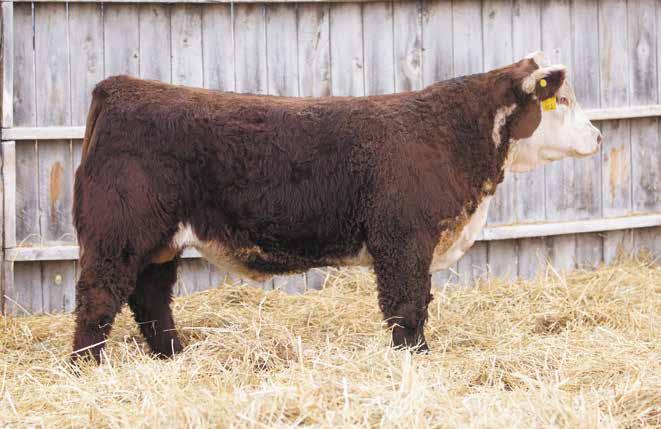
K8 E G41 CANTON K8 POLLED | BD: 3/29/22 | AHA#: 44357321 | Act. BW: 78 lbs. E CANTON G41 E 20C URSULA 9012 NJW 0118 8Y HOMEGROWN 172E ET RSK E 2046 DIGBY ET 20C E 337U DIVA Y37 E T719 PRECIOUS Z35 MCW UDDR TEAT CW FAT REA Marb $BMI $BII $CHB 72 1.4 1.5 68 0.020 0.42 -0.04 $383 $441 $97 CE BW WW YW DMI SC SCF Milk M&G CEM 8.0 1.7 47 73 0.1 0.7 19.5 26 51 2.7 K10 E G41 CANTON K10 POLLED | BD: 4/1/22 | AHA#: 44357313 | Act. BW: 82 lbs. E CANTON G41 E 174E MISS WHOOPSIE 0002 ET NJW 0118 8Y HOMEGROWN 172E ET TH FRONTIER 174E E 337U DIVA Y37 E 332A EDNA D160 MCW UDDR TEAT CW FAT REA Marb $BMI $BII $CHB 91 1.3 1.4 71 0.030 0.51 -0.06 $366 $426 $99 CE BW WW YW DMI SC SCF Milk M&G CEM 6.9 2.3 56 93 0.4 1.1 17.7 34 62 4.7 K8
BW,
E 174E MISS WHOOPSIE 0002 ET Dam of K10 25 All calves are weaned with “Quiet Wean” nose flaps for lower stress impact on calves and cows
Low
high calving ease here. Dam is a standout Digby 20C daughter. K10 Nicely balanced prospect here whose heavily pigmented dam goes back to the 1L Beth cow. K10 is freckle faced.
Gold TPR Breeders
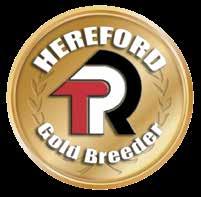
The Gold TPR Breeder recognition is presented to progressive Hereford breeders who have measured traits and collected and promptly submitted performance data at all levels of production. Breeders must meet a specific set of requirements in order to be eligible for the program.
• Herd inventory submitted prior to inventory surcharge deadline.

• Complete reporting of calving ease and reproductive status for each dam on inventory.
• Complete reporting of birth, weaning and yearling weights for all live calves recorded in the calf crop.
• Complete reporting of scrotal measurements for each bull calf with a recorded yearling weight.
• Ultrasound data reported on 25% or more of the calf crop
The basic concept of beef cattle performance records is to measure genetic differences between animals for traits of economic importance. The American Hereford Association (AHA) recognizes the importance of performance records in today’s beef industry and through Whole Herd Total Performance Records (TPR™), can provide a system flexible enough to meet the needs of the most sophisticated record keeping breeder or those who desire to keep only the basics.
Competition for commercial industry purchasing power between and within breeds is keen, and those breeders who document their seedstock’s performance for the commercial man’s investment have a distinct advantage in today’s beef industry as it moves toward “specification production” from conception to slaughter.
Whole Herd TPR is a system of registration and performance tracking whereby every participating breeder updates his/her cow herd inventory annually. The system is positively endorsed by the Beef Improvement Federation (BIF), a North American umbrella organization of beef breed associations, beef producers, researchers and the academic community.
With this system, the AHA measures economically relevant beef production traits such as fertility, longevity and reproductive efficiency. Furthermore, the greater volume of data reported from each herd for measured growth and carcass traits enhances the accuracy of Hereford expected progeny differences (EPDs).

26

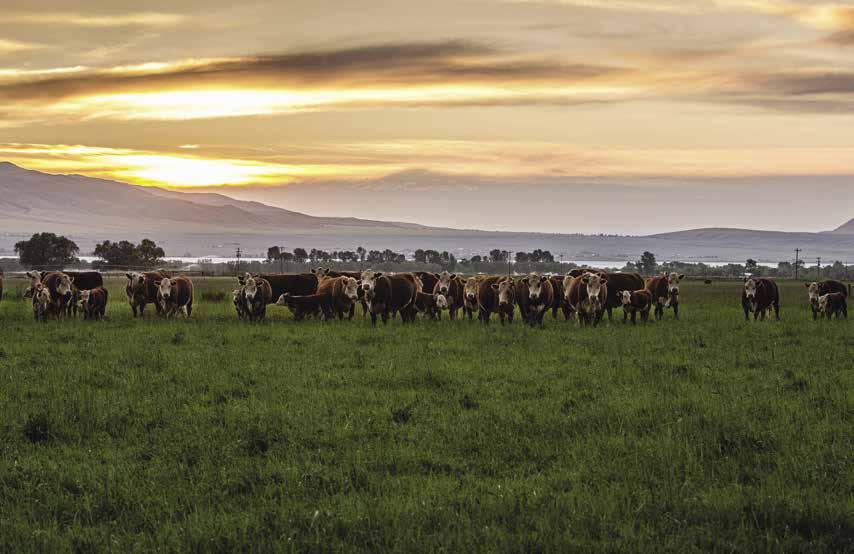


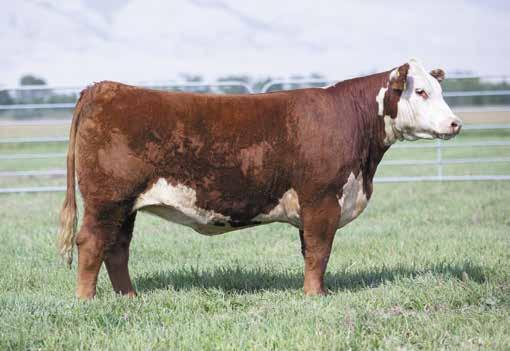

PRODUCTION SALE EHLKE HEREFORDS MONTANA MADE SATURDAY, SEPTEMBER 16, 2023 SMART AUCTIONS ONLINE SALE & RANCH OPEN HOUSE Thank you to our Bidders & Buyers! E 252F Whitney H095 Purchased by Roger Jennings Palmyra, IL E 252F Whitney H072 Purchased by Aaron and Sara Friesz, New Leipzig, ND High Selling Heifers in the 2022 Montana Made Sale 27
Hereford EPDs Understanding
The American Hereford Association (AHA) currently produces expected progeny differences (EPDs) for 17 traits and calculates three profit ($) indexes. AHA’s genetic evaluation makes use of a Marker Effects Model that allows the calculation of EPDs by incorporating the pedigree, phenotypic and genomic profile of an animal. Animals that have a genomic profile will be denoted with a GE-EPD logo. The current suite of Hereford EPDs and $ indexes includes:

Calving Ease — Direct (CE)
CE EPD is based on calving ease scores and birth weights and is measured on a percentage. CE EPD indicates the influence of the sire on calving ease in females calving at 2 years of age. For example, if sire A has a CE EPD of 6 and sire B has a CE EPD of -2, then you would expect on average if comparably mated, sire A’s calves would be born with an 8% more likely chance of being unassisted when compared to sire B’s calves.
Birth Weight (BW)
BW EPD is an indicator trait for calving ease and is measured in pounds. For example, if sire A has a BW EPD of 3.6 and sire B has a BW EPD of 0.6, then you would expect on average if comparably mated, sire A’s calves would come 3 lb. heavier at birth when compared to sire B’s calves. Larger BW EPDs usually, but not always, indicate more calving difficulty. The figure in parentheses found after each EPD is an accuracy value or reliability of the EPD.
Weaning Weight (WW)
WW EPD is an estimate of pre-weaning growth that is measured in pounds. For example, if sire A has a WW EPD of 60 and sire B has a WW EPD of 40, then you would expect on average if comparably mated, sire A’s calves would weigh 20 lb. heavier at weaning when compared to sire B’s calves.
Yearling Weight (YW)
YW EPD is an estimate of post-weaning growth that is measured in pounds. For example, if sire A has a YW EPD of 100 and sire B has a YW EPD of 70, then you would expect on average if comparably mated, sire A’s calves would weigh 30 lb. heavier at a year of age when compared to sire B’s calves.
Dry Matter Intake (DMI)
The Dry Matter Intake EPD predicts the daily consumption of pounds of feed. For example, if sire A has a DMI EPD of 1.1 and sire B has a DMI EPD of 0.1, you would expect sire B’s progeny, if comparably mated, to consume on average 1 pound of feed less per day.
Scrotal Circumference (SC)
Measured in centimeters and adjusted to 365 days of age, SC EPD is the best estimate of fertility. It is related to the bull’s own semen quantity and quality, and is also associated with age at puberty of sons and daughters. Larger SC EPDs suggest younger age at puberty. Yearling sons
of a sire with a .7 SC EPD should have yearling scrotal circumference measurements that average 0.7 centimeters (cm) larger than progeny by a bull with an EPD of 0.0 cm.
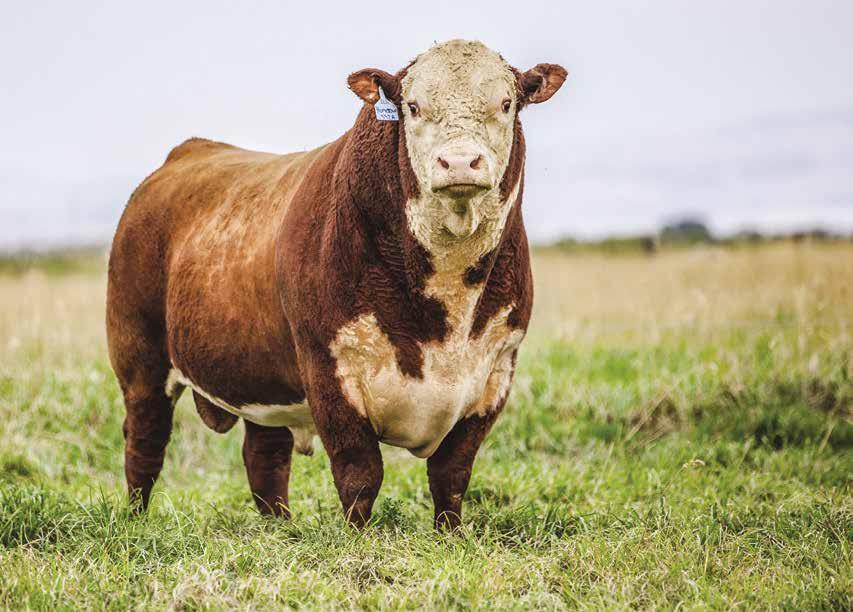
Sustained Cow Fertility
The AHA’s new Sustained Cow Fertility EPD (SCF) is a prediction of a cow’s ability to continue to calve from three years of age through twelve years of age, given she calved as a two-year-old. The EPD is expressed as a deviation in the proportion of the ten-possible calving’s to twelve years old expressed as a probability. For example, the daughters of a bull with a 30 EPD would have the genetic potential to have one more calf by age twelve then the daughters from a bull with a 20 EPD. In other words, the daughters from the 30 EPD bull would have a 10% greater probability of having one more calf than the bull with a 20 EPD. This is equivalent to saying that the daughters are 10% more likely to remain in the herd to age 12.
Maternal Milk (MM)
The milking ability of a sire’s daughters is expressed in pounds of calf weaned. It predicts the difference in average weaning weights of sires’ daughters’ progeny due to milking ability. Daughters of the sire with a +14 MM EPD should produce progeny with 205-day weights averaging 24 lb. more (as a result of greater milk production) than daughters of a bull with a MM EPD of -10 lb. (14 minus -10.0 = 24 lb.). This dif-
28
ference in weaning weight is due to total milk production during the entire lactation.
Maternal Milk & Growth (M&G)
Maternal Milk & Growth reflects what the sire is expected to transmit to his daughters for a combination of growth genetics through weaning and genetics for milking ability. It is an estimate of daughters’ progeny weaning weight. A bull with a 29 lb. M&G EPD should sire daughters with progeny weaning weights averaging 19 lb. heavier than progeny of a bull’s daughters with a M&G EPD of 10 lb. (29 minus 10 = 19 lb.). It is equal to one-half the sire’s weaning weight EPD, plus all of his MM EPD. No accuracy is associated with this since it is simply a mathematical combination of two other EPDs. It is sometimes referred to as “total maternal” or “combined maternal.”
Maternal Calving Ease (MCE)
MCE EPD predicts how easily a sires daughters will calve at 2 years of age and is measured on a percentage. For example, if sire A has a MCE EPD of 7 and sire B has a CE EPD of -3, then you would expect on average if comparably mated, sire A’s daughters would calve with a 10% more likely chance of being unassisted when compared to sire B’s daughters.
Mature Cow Weight (MCW)
The MCW EPD was designed to help breeders select sires that will either increase or decrease mature size of cows in the herd. The trait was developed after years of cow weight data collection and the EPD relates directly to the maintenance requirements of a cow herd. For example, if sire A has a MCW EPD of 100 and sire B has an EPD of 85, then you would expect the females of sire A, if mated to similar cows, to be 15 lb. heavier at mature size.
Udder suspension (UDDR)
UDDR EPDs are reported on a 9 (very tight) to 1 (very pendulous) scoring scale. Differences in sire EPDs predict the difference expected in the sires’ daughters’ udder characteristics when managed in the same environment. For example, if sire A has a UDDR EPD of 0.4, and sire B has a UDDR EPD of -0.1, the difference in the values is 0.5, or one-half of a score. If daughters of sires A and B are raised and managed in the same environment, you would expect half a score better udder suspension in daughters of sire A, compared to sire B.
Teat size (TEAT)
TEAT EPDs are reported on a 9 (very small) to 1 (very large, balloon shaped) scoring scale. Differences in sire EPDs predict the difference expected in the sires’ daughters’ udder characteristics when managed in the same environment. For example, if sire A has a teat size EPD of 0.4, and sire B has a teat size EPD of -0.1, the difference in the values is 0.5, or one-half of a score.
If daughters of sires A and B are raised and managed in the same environment, you would expect half a score smaller teat size in daughters of sire A, compared to sire B.
Carcass Weight (CW)
Carcass weight is a beneficial trait when considering the impact that pounds have relative to end product value. At the same age constant endpoint, sires with higher values for carcass weight will add more pounds of hot carcass weight compared to sires with lower values for carcass weight. For example, if sire A has a CW EPD of 84 and sire B has a CW EPD 64, then you would expect the progeny of sire A, if harvested at the same age constant endpoint, to have a 20lb. advantage in terms of hot carcass weight.
Rib Fat (FAT)
The FAT EPD reflects differences in adjusted 365-day, 12th-rib fat thickness based on carcass measurements of harvested cattle. Sires with low, or negative FAT EPDs are expected to produce leaner progeny than sires with higher EPDs. Ultrasound measures are also incorporated into this trait and have been shown to be highly correlated with the performance of slaughter progeny. All data is expressed on a carcass scale.
Ribeye Area (REA)
REA EPDs reflect differences in an adjusted 365day ribeye area measurement based on carcass measurements of harvested cattle. Sires with relatively higher REA EPDs are expected to produce better- muscled and higher percentage yielding slaughter progeny than will sires with lower REA EPDs. Ultrasound measurements are also incorporated into this trait and have been shown to be highly correlated with the performance of slaughter progeny. All data is expressed on a carcass scale.
Marbling (MARB)
MARB EPDs reflect differences in an adjusted 365-day marbling score (intramuscular fat, [IMF]) based on carcass measurements of harvested cattle. Breeding cattle with higher MARB EPDs should produce slaughter progeny with a higher degree of IMF and therefore higher quality grades. Ultrasound measurements are also incorporated into this trait and have been shown to be highly correlated with the performance of slaughter progeny. All data is expressed on a carcass scale.
Baldie Maternal Index (BMI$)
The Baldy Maternal Index is a maternally focused index that is based on a production system that uses Hereford x Angus cross cows. Progeny of these cows are directed towards Certified Hereford Beef. This index has significant weight on Sustained Cow Fertility, which predicts fertility and longevity of females. There is a slightly positive weight on Weaning Weight,

Mature Cow Weight and Milk which accounts for enough growth but ensures females do not increase inputs. There is some negative emphasis on Dry Matter Intake, but a positive weighting on Carcass Weight which is anticipated to provide profitability from finishing of non-replacement females and castrated males. Marbling and Rib-eye Area are also positively weighted to keep the harvested progeny successful for CHB. This index is geared to identify Hereford bulls that will be profitable when used in a rotational cross with mature commercial Angus cows.
Brahman Influence Index (BII$)
The Brahman Influence Index is a maternally focused index that is based on a production system that uses Brahman x Hereford cross cows. Progeny of these cows are directed towards a commodity beef market since Certified Hereford Beef does not accept Brahman influenced cattle. This index has significant weight on Sustained Cow Fertility, which predicts fertility and longevity of females. There is a slightly positive weight on Weaning Weight, Mature Cow Weight and Milk which accounts for enough growth but ensures females do not increase inputs. There is some negative emphasis on Dry Matter Intake, but a positive weighting on Carcass Weight which is anticipated to provide profitability in finishing non-replacement females and castrated males. Marbling and Rib-eye Area are also positively weighted to keep harvested progeny successful for a variety of commodity based programs. This index targets producers that use Hereford bulls on Brahman influenced cows.
Certified Hereford Beef Index (CHB$)
The Certified Hereford Beef Index is a terminal sire index that is built on a production system where Hereford bulls are mated to mature commercial Angus cows and all progeny will be targeted for Certified Hereford Beef after the finishing phase. This index has significant weight on Carcass Weight to ensure profit on the rail. As well there is a positive weighting for Average Daily Gain along with a negative weighting on Dry Matter Intake to ensure efficient pounds of growth in the finishing phase. Keep in mind, this production system takes advantage of complimentary breeding with the commercial Angus cow. Although Marbling is weighted positively in this index, a positive weighting for Rib-eye Area and a negative weighting for Back Fat are a greater priority in this index to allow for optimum end-product merit. This is the only index that has no emphasis on fertility. Remember that no replacement heifers are being retained.
We
EPD table.
CE BW WW YW MM M&G SC Fat REA Marb BMI$ BII$ CHB$ 2.9 2.8 54 87 26 53 1.0 0.018 0.41 0.12 342 413 115 Breed Average EPDs
are showing the most commonly used EPDs and Indexes for each animal. We are offering the AHA explanation of all the EPDs and indexes currently being calculated by the American Hereford Association. If you would like to see a bull’s EPD that we do not show in the catalog, you can look it up online at www.hereford.org or ask one of us. Following is the most current Hereford Average
Please keep in mind that EPD averages/baselines are different between breeds.
Townsend, MT 59644

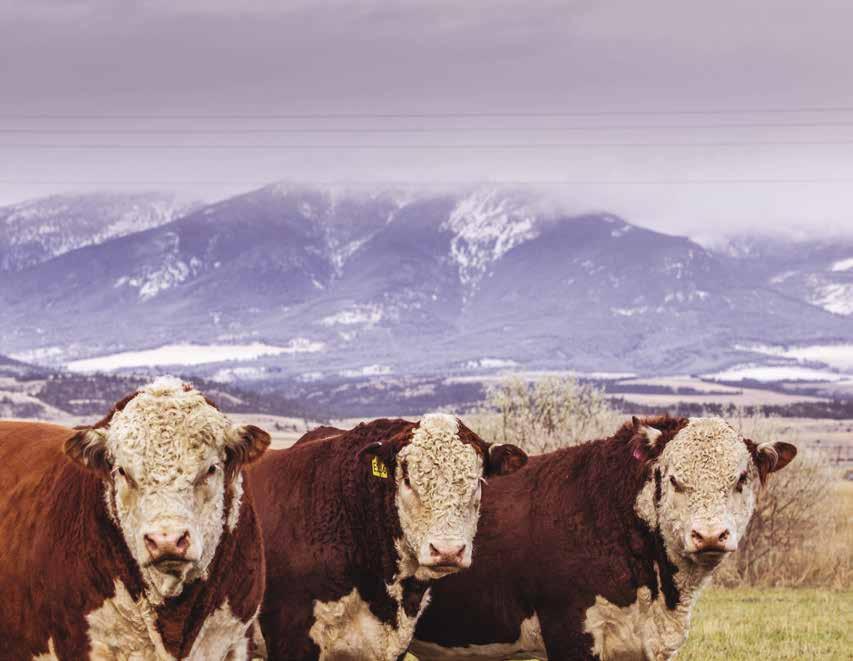

P.O. Box 178
www .gener ation6.c o
Catalog designed by

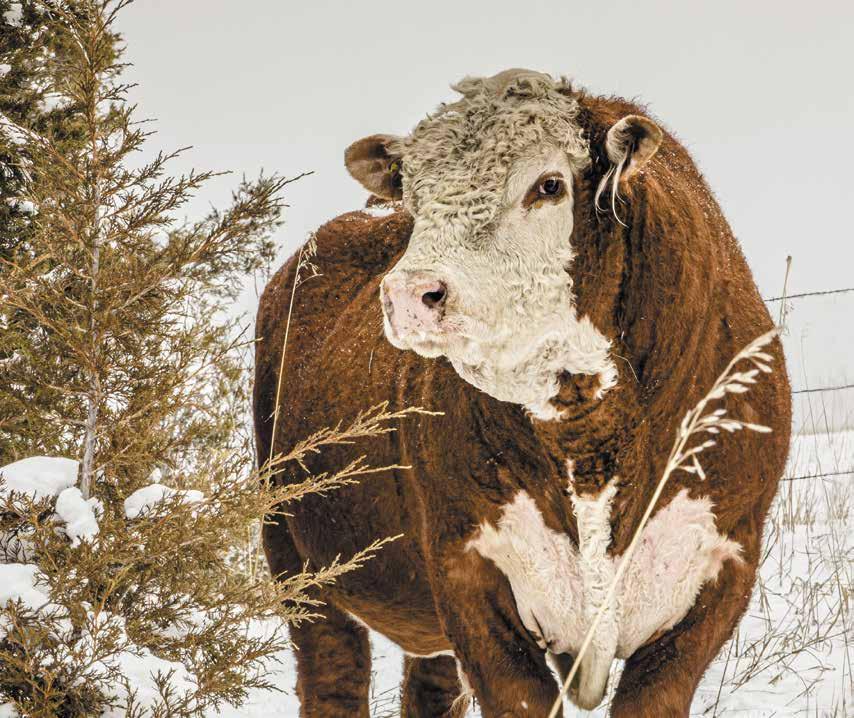

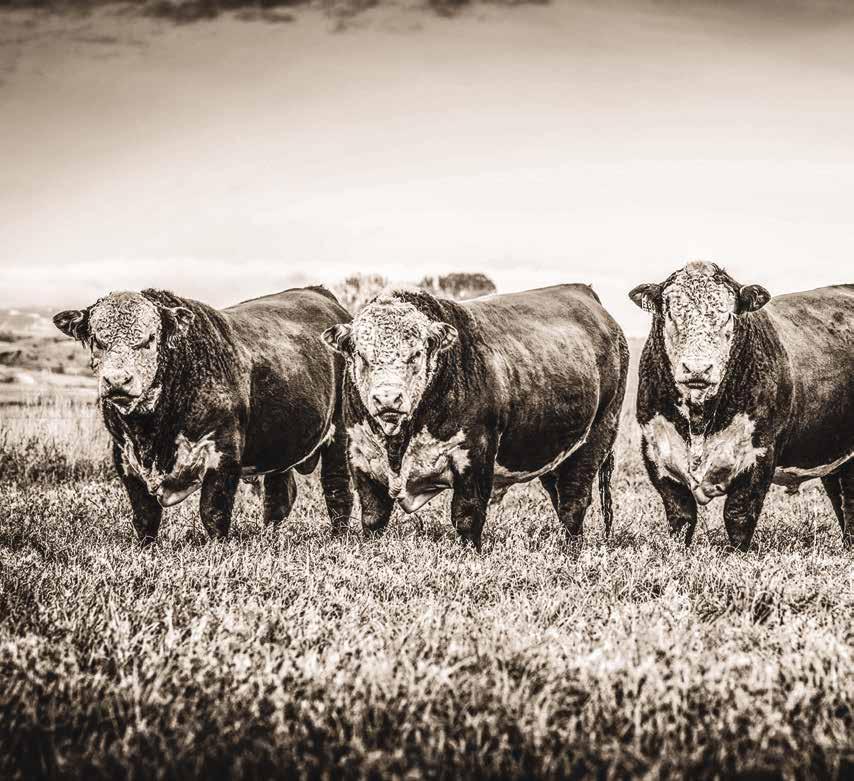









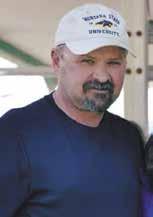








 GE•EPD AHA
GE•EPD AHA





















































































